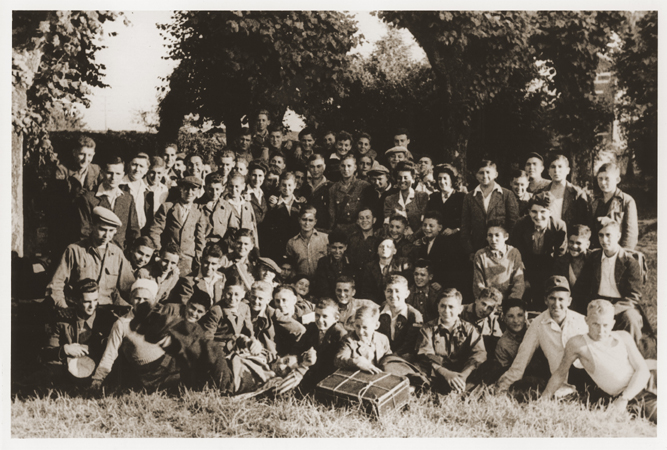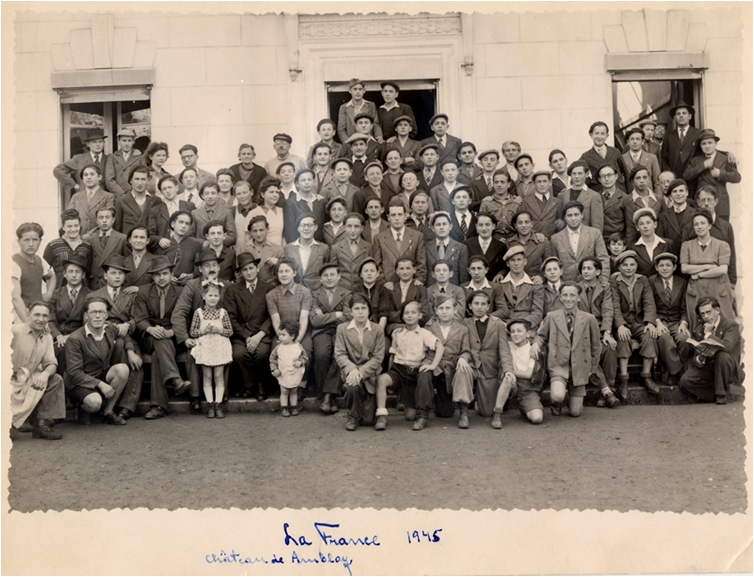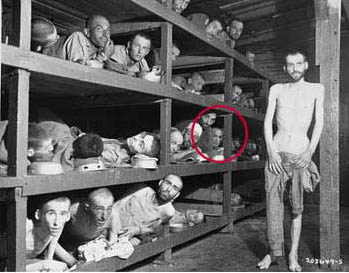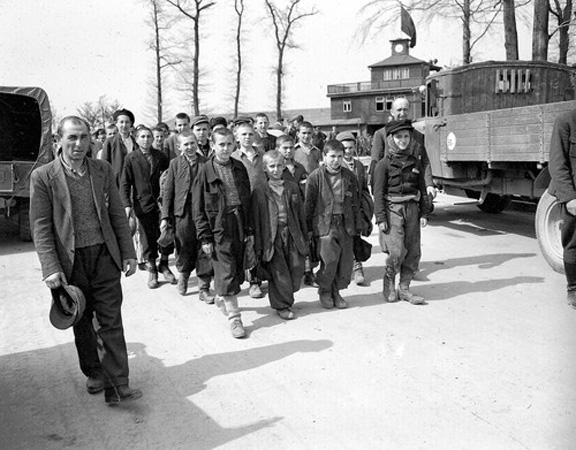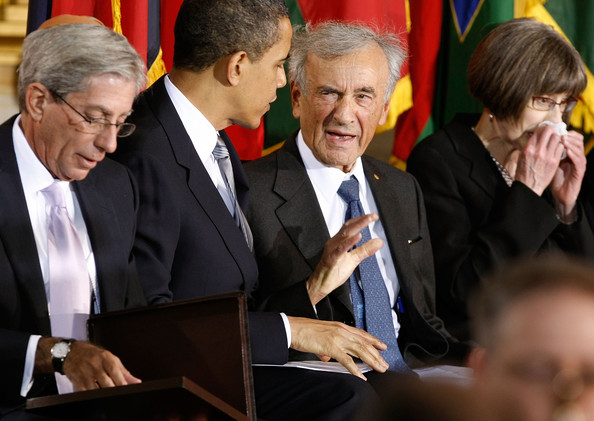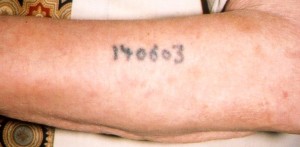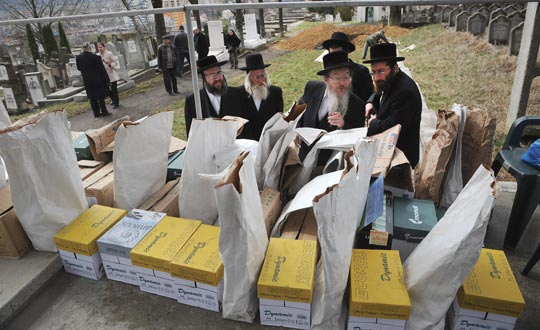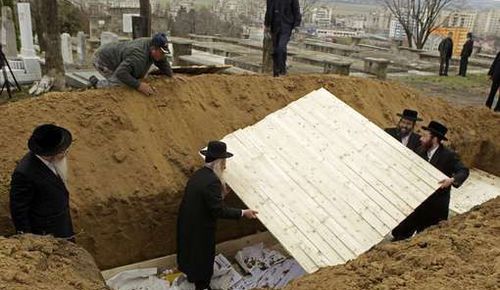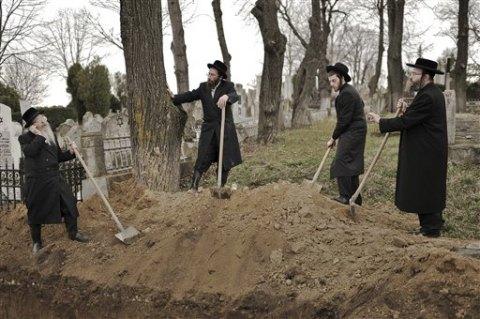Blog
Ken Waltzer Replies to My Question
Written on June 30, 2011 at 7:35 pm, by Carolyn
By Carolyn Yeager
(Last edited on July 3 and added to on July 9)
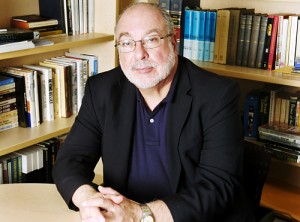 In my previous blog of June 14, I asked the question “What happened to Waltzer’s book about the ‘boys of Buchenwald?’” On June 27, Ken Waltzer (pictured right) answered me … sort of. He said he was not having any trouble with the book, but he didn’t say when we could expect to read it. Not a word on that. But he assured Elie Wiesel Cons the World readers that we will find it a powerful story when we do.
In my previous blog of June 14, I asked the question “What happened to Waltzer’s book about the ‘boys of Buchenwald?’” On June 27, Ken Waltzer (pictured right) answered me … sort of. He said he was not having any trouble with the book, but he didn’t say when we could expect to read it. Not a word on that. But he assured Elie Wiesel Cons the World readers that we will find it a powerful story when we do.
Being a person who likes to stick with the practical and real, I’m not satisfied with Prof. Waltzer’s answer because it avoids the real questions in favor of repeating his claims without supporting them. On top of that, he called me a bigot. This is a grievous fault, it seems to me, in a man who is a Professor of Jewish Studies and German History at Michigan State University. Let’s take a look at what he’s said.
Before writing a comment to my blog, Waltzer first wrote a comment on June 26 to Scrapbookpages Blog. The blogmaster there, who goes by the name of “furtherglory,” had blogged June 16 on my ‘boys of Buchenwald’ article. He checks out new articles about Holocaust on the Internet daily, and seems pretty interested in Elie Wiesel. He added an update to the original blog and asked the question: “Has Ken Waltzer finally figured out that there were three separate people involved in this controversy and all three are named Wiesel.” No, he hasn’t. Waltzer continues to insist that they are all Elie Wiesel.
This is what Ken Waltzer said on Scrapbookpages Blog:
All the ridiculous claims that Wiesel was not Wiesel, Wiesel was not at Buchenwald, Wiesel was a different Wiesel are false, There was one Lazar Wiesel at Buchenwald. He arrived with his father, who appears as Abram, born 1900, and who died shortly after arrival. (He signs his name Shlomo.) Wiesel was then moved to block 66, the children’s block, part of a large child-saving operation by people aligned with the German-Communist led international underground in the camp. He is there with others from Sighet who affirm he is there. He is there until liberation. He is interviewed by American military authorities there. He goes to France.,…
There is no question, indeed there is firm proof, Elie Wiesel was at Buchenwald. And the sections of Night written about Buchenwald are generally accurate and conform to the experience he had.
Comment by Ken Waltzer — June 26, 2011 @ 6:53 am
And this is what Furtherglory said in reply:
Thanks for your comment. A man named Lazar Wiesel was given the tattoo number A-7713 at Auschwitz. A man named Abram Viesel was given the number A-7712 at Auschwitz. Both of them were transferred to Buchenwald in January 1945. Lazar Wiesel, born at Maromarossiget on 4 September 1913, an apprentice locksmith, political detainee and Hungarian Jew, was registered at Buchenwald on 26 January 1945 and assigned the ID number 123565. This must be the man whom you have identified as Elie Wiesel and Abram Viesel is the man that you have identified as Elie’s father. In the records at Auschwitz, Abram Viesel was born on 10 October 1900 at Marmarosz. He was old enough to be Elie Wiesel’s father, but not old enough to be the father of Lazar Wiesel, who was born in 1913, according to the records.
Elie’s full name is Eliezer Wiesel and he was born in Sighet, Romania (Marmarossiget) which was a part of Hungary in 1944. Elie claims he was born on September 30, 1928. Are you saying that his birthdate was mistakenly written as Sept 4, 1913 at Buchenwald?
A man named Lázár Wiesel, (note difference in spelling) born 4 October 1928, was also registered at Buchenwald and given the ID Number 123165. Are you saying that this man did not exist?
You wrote that Elie Wiesel (Lazar Wiesel) was interviewed by the American military. Lázár Wiesel filled out a US Army questionaire on 22 April 1945 at Buchenwald; he stated on the questionaire that he was born at Màromarossziget on 4 October 1928; he was a student who was arrested on 16 April 1944 and interned at Auschwitz and Monowitz. Are you saying that this man didn’t exist?
The records at the Buchenwald Gedenkstätte show that Lázár Wiesel was sent to Paris on 16 July 1945 with a convoy of surviving children and is registered on the transport list. The name Lazar Wiesel is not on the transport list to Paris, which makes sense since he was born in 1913.
Lazar Wiesel’s name was on the transport list from Auschwitz to Buchenwald, but the name Lázár Wiesel was not. That doesn’t mean that Lázár was never at Auschwitz. He could have been sent, from Auschwitz, to some other camp, such as Gross Rosen, and then sent to Buchenwald when Gross Rosen, or whatever other camp, was evacuated.
Comment by furtherglory — June 26, 2011 @ 3:40 pm
It didn’t take furtherglory long to answer Prof. Waltzer and I thought he did a fantastic job. I mean, he’s got it all right and in order and that’s why I’m copying it here … so I won’t have to do it myself. Furtherglory asked Prof. Waltzer some questions, but Waltzer has not yet answered them. I have a feeling he won’t, either, because he doesn’t like to answer questions that he hasn’t posed himself, or are not easy ones. You see, Waltzer spends most of his time talking to his brainwashed students or to Jewish people at Jewish group events, like at the U.S. Holocaust Memorial Museum. Did you know that Jews run that museum and make up most of the attendees at its events? See here. They never ask tough questions.
But still, I was very happy to find a comment on my blog from Prof. Waltzer and I thank him for it. I think it says a lot for him that he is willing to engage, even if only to this extent. He wrote:
by Ken Waltzer On June 27, 2011 at 2:26 pm
Carolyn Yeager suspects that Ken Waltzer is having trouble with his Buchenwald book, esp. proving Elie Wiesel was at Buchenwald as he says he was. Nothing could be further from the truth.
The Buchenwald book is drawn on survivors’ experiences interviewed around the world and on documents from the Red Cross ITS and it will tell a powerful story of endurance and rescue inside Buchenwald.
And related to that larger story, in which Elie Wiesel is merely one of many boys who were helped and saved inside Buchenwald, there simply is no mystery whatsoever of Elie Wiesel, as Yeager claims. He arrived from Buna on a terrible transport on Jan. 26, 1945, with many others (including Miklos Gruner); he was accompanied by his father, who was recorded as Abram (but who signed his name as Shlomo); they were initially together in a barrack in the little camp, 59, I think, and then — after his father died — Elie Wiesel was moved in early February to block 66, the kinderblock. Miklos Gruner too was in block 66. Elie Wiesel was there with other boys from Sighet, who knew him; he was interviewed by military authorities after liberation, in order to permit departure from the camp; and he went after liberation in early June, 1945, to France, to Ecouis…. one among 425 boys who did so. He appears in subsequent pictures at Ambloy and Taverny where the religious boys were taken after Ecouis….
More important, Elie Wiesel’s commentary in Night bears fairly close resemblance to the actual experiences he had at Buchenwald — as recorded in camp documents.
He is the truth teller — Carolyn Yeager; you are the dealer in false claims and bigoted charges.
I am a bigot for doubting Elie Wiesel. I guess it’s some form of antisemitism to doubt that every word Elie Wiesel says is absolutely true … because he is the truth teller, according to Waltzer. And he, Waltzer, is going to prove it.
I consider what Prof. Waltzer is doing similar to ‘sleight of hand.’ He‘s repeating what he’s been saying all along … with a few convenient omissions (for example, the paper proving it he promised 6 months ago). We are to believe that 1) Eliezer Wiesel was listed as Lazar when he arrived, and then as Lázár Wiesel after liberation, with the wrong birth date both times; 2) his father Shlomo was recorded as Abram, also with the wrong birth date; 3) Shlomo is short for Abram or Abraham, not Solomon; and 4) those crazy, mixed-up Nazis got their records wrong.
Has Waltzer managed to falsify some document to show that the elder Wiesel was also known at times as Abraham? We’ll see. Then there is the problem with the pictures. He hasn’t told us which of these boys arriving at Ecouis in France in 1945 is Elie Wiesel. The USHMM tells us Elie is in this picture but doesn’t say where. Can you find him?
He also didn’t point out to us which of these ‘religious boys’ is Elie Wiesel. He titled it “In France — religious boys, including Elie Wiesel.” But how can we be sure?
What he seems to be doing is moving the attention away from these pictures to others of Elie Wiesel at Ambloy and Taverny. If there are such pictures I have never seen them. Have they been newly created? Why keep them hidden all these many years? (post note: See Comments #1,2 and 3) Does this mean that Waltzer is now declining to say that Wiesel appears in the famous Buchenwald photo (below)?
Or in this photo of the boys marching out of Buchenwald after liberation—which he has claimed for several years?
Prof. Waltzer, I know you consider yourself one of the privileged of the world, along with Elie Wiesel, but you must realize that even people of such privilege as yourselves cannot just change Shlomo to Abram as it suits you. When all others who were ‘liberated’ from the German camps are identified by matching their names, birth dates, and prisoner numbers, you cannot decide that in certain cases this formula does not apply and it is YOU who decides who is who.
From your comments, I’m expecting that when your book does finally come out, it will say that Shlomo is Abram and birth dates don’t matter, and this will be a small portion of the book overshadowed by other “powerful” stories of Jewish children. There may be no pictures of Elie Wiesel in France because he is just one of many in your powerful story. It will receive praise, coordinated in advance, from the Jewish media and academic class and no concern whatsoever will be expressed about any contradiction with the facts as they are contained in the Buchenwald archival documents.
But there will be one entity that will not let you alone or off the hook, and that is Elie Wiesel Cons The World website, and maybe some of our readers and followers. So I say—thanks for the comment but we are still waiting and watching for clarification from you.
UPDATE (July 1st):
Shlomo Wiesel was never at Auschwitz or Buchenwald. If he had been at Auschwitz there would be a record for a man named Solomon Viezel or Wiesel born in 1894, who was 50 years old in 1944.
>>We read in Frank N. Magill, ed., “Great Events from History II: Arts And Culture Series: Volume 4, 1955-1969“, Salem Press, Inc., Pasadena, CA., 1993, p. 1700:
“SHLOMO WIESEL (1894-1945), the father of Elie Wiesel“
>>And in in Michaël de Saint Cheron, “Elie Wiesel : L’homme de la mémoire“, Paris, Bayard (coll. Biographie), 1998, p. 25:
“Quant à son père, Shlomo, il ne fut vraiment proche de lui que dans les camps, ces lieux hors du temps, hors de l’espace des vivants, où ils partagèrent le même sort, le même enfer, ou presque.
Son père, né en 1894, à Màrmarossziget, était un juif tolérant et éclairé, alors que sa mère, née en 1898 à Bocsko, cadette de six enfants devenue orpheline de bonne heure, très pieuse, (Translation: His father Shlomo, born in 1894, in Marmarossziget, and his mother, born in 1898 in Bocsko.)
>>More importantly, Elie Wiesel filled out a form for the Yad Vashem Memorial in Israel sometime after the year 2000 (as my memory serves me) stating his father died as a holocaust victim.** On that form, he gave his father’s name as: Shlomo Vizel. He didn’t give a date of birth, but he gave a date of death as Jan. 27, 1945 and the cause of death as: Disease. He signed himself as Eli Vizel, son. That form can be viewed at the Yad Vashem archives online; that’s where I saw it.
Nowhere has Shlomo Vizel (Wiesel) ever been called Abram or Abraham, except now by Ken Waltzer in order to fit with the records for Lazar and Abram Wiesel at Buchenwald.
Stealing real victims and survivors identity is one of the lowest forms of behavior, according to holocaust survivor groups … or so they say. What do you think?
** It should be noted that Elie Wiesel did not fill out Yad Vashem forms for his mother or youngest sister affirming them as victims of the Holocaust. Why not? The logical reason is that he does not have any knowledge that they were indeed taken immediately to a “gas chamber” and killed, as the story has been put out for public comsumption. Even on Wiesel’s main page at Wikipedia it says they were “presumably killed.” That is all. Neither did his two older sisters, who were supposedly at Auschwitz for several months before being transferred to a sub-camp of Dachau, fill out this form for their mother and sister even though they are said to have been all together in the women’s line. These two surviving sisters were totally silent about their WWII experience, in spite of their famous brother, until Hilda, the eldest, gave a videotaped testimony to Steven Spielberg’s Shoah Foundation in the 1990’s.
What happened to Waltzer’s book about the ‘boys of Buchenwald?’
Written on June 14, 2011 at 10:10 pm, by Carolyn
by Carolyn Yeager
MSU Prof. Kenneth Waltzer has been promising his book The Rescue of Children and Youth in Buchenwald since 2007. Four years later, he’s being very quiet about it.
Here is a timeline of announcements about this work in progress, all taken from his Michigan State University website.
May 2005: Professor Waltzer presented a paper, “The Rescue of Children at Buchenwald: Behavior in a Grey Area,” at the Midwest Jewish Studies Scholars Colloquium, Cohn-Haddow Judaic Studies Program, Wayne State University, Detroit.
March 2007: Ken Waltzer will present a paper on “The Kovno Boys: Survival at Auschwitz, Buchenwald, and Mauthaussen,” at the 37th Annual Holocaust Scholars Conference in Cleveland, Ohio.
April 2007: Ken Waltzer presents on his book-in-progress, The Rescue of Children and Youth in Buchenwald, at James Madison College.
May 2008: MSU Professor Ken Waltzer gave the Monna and Otto Weinmann Lecture at the U.S. Holocaust Memorial Museum on the subject of his upcoming book on the rescue operation at Buchenwald that he said saved the lives of hundreds of children and youths.
April 2010: Kenneth Waltzer, professor of history and director of the Jewish studies program at Michigan State University, is currently completing a book about the rescue of children and youths at Buchenwald. [From the April 16, 2010 The Jewish Daily Forward]
The Elie Wiesel Problem
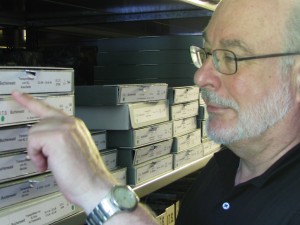 Prof. Waltzer has written and shown pictures of himself (right) doing research at Bad Arolson in Germany, seeking to discover details about the lives and families of the boys of Buchenwald. One of the boys that he may be having trouble with is Elie Wiesel. Waltzer has made a lot of claims and put himself on the line about Wiesel that, in this writer’s opinion, cannot be substantiated.
Prof. Waltzer has written and shown pictures of himself (right) doing research at Bad Arolson in Germany, seeking to discover details about the lives and families of the boys of Buchenwald. One of the boys that he may be having trouble with is Elie Wiesel. Waltzer has made a lot of claims and put himself on the line about Wiesel that, in this writer’s opinion, cannot be substantiated.
For example, last November Waltzer commented on this website to my article “Signatures Prove Lázár Wiesel is not Elie Wiesel” with the following:
Contrary to Carolyn Yeager’s wishful thinking, Eli Wiesel was indeed the Lazar Wiesel who was admitted to Buchenwald on January 26, 1945, who was subsequently shifted to block 66, and who was interviewed by military authorities before being permitted to leave Buchenwald to go with other Buchenwald orphans to France. Furthermore, there is not a shadow of a doubt about this, although the Buchenwald records do erroneously contain — on some pieces — the birth date of 1913 rather than 1928. A forthcoming paper resolves the “riddle of Lazar” and indicates that Miklos Gruner’s Stolen Identity is a set of false charges and attack on Wiesel without any foundation. ~~ by kenwaltzer on November 14, 2010 at 10:34 am
The birthdate on Lazar Wiesel’s records is erroneous—that’s his answer? He is going to “resolve” that? The “forthcoming paper” has not yet appeared 7 months later. His website pages have not been updated for awhile; in fact, they look downright dormant.
Here are the problems I think Waltzer is having, in addition to the birthdate problem:
- He has claimed for at least several years that a picture he has placed on his website of the boys walking out of the Buchenwald front gate shows Elie Wiesel “toward the left.” [See The Many Faces of Elie Wiesel] I say it is not Elie Wiesel, and I don’t know anyone but Waltzer who has identified this boy as Elie Wiesel. This picture is also shown on the USHMM website, and they make no mention of Elie Wiesel as one of the boys.
- In a Power Point presentation that is available on his website, Waltzer shows a group picture of the ‘religious boys’ out of those who went to France, that he says includes Elie Wiesel. I have studied this picture closely and do not see anyone who resembles Wiesel. If Waltzer knows that Elie Wiesel is in the picture, why doesn’t he identify him with an arrow?
Famous Buchenwald Liberation photo is another problem
As I pointed out in “The Many Faces of Elie Wiesel,” the pictures that Waltzer claims contain the face and person of Elie Wiesel do not resemble each other. The famous barracks photo which the New York Times declared to be Elie Wiesel as a 16-year old Buchenwald inmate—and is reproduced all over the world as Elie Wiesel—doesn’t look like the other 16-year old faces.
This writer suspects that Ken Waltzer is having difficulty convincingly incorporating Elie Wiesel into the story of the “boys of Buchenwald” and their rescue. He has been a friend and devotee of Wiesel for many years, they are both strongly associated with the U.S. Holocaust Memorial Museum, and Wiesel has been a part of his Buchenwald story from the beginning. But the real evidence for Elie Wiesel ever being an inmate at Buchenwald doesn’t exist. There are no photographs of Elie Wiesel at Buchenwald; there are no photos of Wiesel during his supposed one-year concentration camp period at all.
I think Waltzer believed this slipshod approach he employs would pass without comment, but he didn’t count on the appearance of Elie Wiesel Cons the World website. We are a real problem for Ken Waltzer!
Awards people give themselves
Written on May 11, 2011 at 12:20 pm, by Carolyn
Above: U.S. President Barack Obama with U.S. Holocaust Memorial Council Chairman Fred Zeidman (L), Elie Wiesel (2nd from R) and Holocaust Memorial Museum Director Sara Bloomfield (R) at the “Holocaust Days Of Remembrance” ceremony in the Rotunda of the U.S. Capitol April 23, 2009 in Washington, DC. Established in 1993, the Days of Remembrance are commemorated in April so that they coincide with the observance in Israel. (Photo by Chip Somodevilla/Getty Images)
By Carolyn Yeager
It has just been announced that Elie Wiesel will be the recipient of the FIRST U.S. Holocaust Memorial Museum Award. Not a surprise. Wiesel is the one upon whom the “Holocaust Industry” feels safe in heaping praise, therefore he has enough “distinguished service” type awards to wallpaper a room.
What has he done to actually deserve them? He has been in the service of the outlaw state of Israel for most of his long life, condoning the dispossession of the native Palestinian people, and even their destruction by napalm bombing and massacres carried out on a regular basis. He’s not really a very good liar, although a prolific one, and so his self-created life story is not convincing to a mind that has even a little bit of critical capacity.
If we search earnestly for what this man has actually accomplished, we find a mixture of self-promotion and Holocaust “memory” promotion. In other words, Wiesel is a promoter. He’s made his name synonomous with The Holocaust. Of course, he’s been helped in this by powerful organizations, not least of which is the New York Times Corporation. That is a story that is yet to be told on this website, but it has been well-explored by Prof. David O’Connell in his article “Elie Wiesel and the Catholics.”
Wiesel’s so-called “humanitarian work” has been directed almost exclusively to help Jews and Jewish causes. He makes statements now and then about other groups, such as Africans in Darfur, but mostly ignores all those who are currently in distress in the world today in favor of receiving large sums of money to speak about the Jewish past. He will be doing the same when he receives the award from the USHMM on May 16 – an award that may very well have a sum of money attached to it. Money, by the way, that will be coming from the pockets of U.S. taxpayers!
 Instead of celebrating this whole hypocritical affair, we should be sickened by it. According to USHMM director Sara Bloomfield, right, (see Bradley Smith’s youtube conversation with Sara), who will present the award, “no one else has done so much (as Wiesel) to honor the victims of the Holocaust by working tirelessly to create a more just world in their memory.” Hmmm. Once again, a more just world for Jews. She explains he does this by his “conviction that the Museum should be a ‘living’ memorial.” She doesn’t explain what makes it ‘living’ and don’t expect her to. These are just words that are designed to stir emotions or good feelings in the hearer, and is what they expect. By such words we are to accept that “His legacy to humanity is unique and extraordinary.” Just don’t ask questions.
Instead of celebrating this whole hypocritical affair, we should be sickened by it. According to USHMM director Sara Bloomfield, right, (see Bradley Smith’s youtube conversation with Sara), who will present the award, “no one else has done so much (as Wiesel) to honor the victims of the Holocaust by working tirelessly to create a more just world in their memory.” Hmmm. Once again, a more just world for Jews. She explains he does this by his “conviction that the Museum should be a ‘living’ memorial.” She doesn’t explain what makes it ‘living’ and don’t expect her to. These are just words that are designed to stir emotions or good feelings in the hearer, and is what they expect. By such words we are to accept that “His legacy to humanity is unique and extraordinary.” Just don’t ask questions.
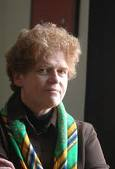 Those lucky enough to attend this dinner will also be able to hear Deborah Lipstadt, left, who will give a speech to promote her new book The Eichmann Trial. In fact, this year of 2011 was picked for the first award because it is the 65th anniversary of the verdicts at the first Nuremberg trial and the 50th anniversary of the trial of Adolf Eichmann. They can’t let “memory” die out, you know. And there is also that need to mark anniversaries of the most sacred dates in the Holocaust religious calendar.
Those lucky enough to attend this dinner will also be able to hear Deborah Lipstadt, left, who will give a speech to promote her new book The Eichmann Trial. In fact, this year of 2011 was picked for the first award because it is the 65th anniversary of the verdicts at the first Nuremberg trial and the 50th anniversary of the trial of Adolf Eichmann. They can’t let “memory” die out, you know. And there is also that need to mark anniversaries of the most sacred dates in the Holocaust religious calendar.
P.S. A postscript to Seven-up: Here is your chance to leaflet a Wiesel event in person. Hop on a plane and get yourself to the Wardman Park Marriott Hotel in Wash. D.C. by May 16th and you’ve got it made. Remember, you can download leaflets questioning Wiesel’s tattoo by clicking on the Downloads button on our menu bar—if you don’t have any leaflets of your own. Good luck and let us know how it went.
The Wiesel tattoo issue remains “most sensitive” for readers
Written on May 1, 2011 at 11:32 am, by Carolyn
by Carolyn Yeager
Today, May 1st, Elie Wiesel Cons The World received the 17th comment on the blogpost “Is Elie Wiesel a perjurer?” This is the most comments for any article posted here except for our very first “Welcome” blog .
Six ‘believers’ were disturbed enough by this article to write a comment scolding us for it. This tells me that the idea that Elie Wiesel does not have a tattoo, yet says he does, is the most worrisome issue for believers. They get angry when faced with the proof that Elie Wiesel tells lies. They have no way to talk around it.
Realizing this, I am re-posting that article with some added material which I have put in brackets []. This version of the article should be circulated as widely as possible to the mainstream media and mainstream commentators by those of you who want to see some action on this.
Is Elie Wiesel a perjurer?
Written on August 24, 2010 at 10:01 am, by Carolyn Yeager
Elie Wiesel stated under oath while giving testimony in the trial of Eric Hunt in San Francisco, California in July 2008 that the number A7713 was tattooed on his left arm. (see Where is the Tattoo?)
Wiesel should have been asked to show his tattoo to the court at that time, but he wasn’t. This was a failure of the defense, for sure. But obviously, at that time, Mr. Hunt, the defendant, was not questioning whether Elie Wiesel had been an inmate of Auschwitz-Birkenau.
Since then, Mr. Hunt and others have uncovered video photography of Wiesel’s bare left arm from all angles, leaving no reasonable doubt that no tattoo is there. Backing up this conclusion is the fact that Wiesel has also famously refused to ever show his tattoo when requested to do so. For those who will retaliate that Wiesel may have had the tattoo removed, he said as late as March 25, 2010 that he still had the number A7713 on his arm. (see Where is the Tattoo?) [In September or October 2012, AP reporter Verena Dobnik wrote in a published news report that Elie Wiesel showed her his tattoo during an interview. Wiesel has never denied the story.]
From this, the average man on the street would probably agree that Elie Wiesel has committed perjury (a criminal offense) if he does not indeed have the number tattooed on his arm. The law, according to http://www.lectlaw.com/def2/p032.htm, says:
When a person, having taken an oath before a competent tribunal, officer, or person, in any case in which a law of the U.S. authorizes an oath to be administered, that he will testify, declare, depose, or certify truly, or that any written testimony, declaration, deposition, or certificate by him subscribed, is true, willfully and contrary to such oath states or subscribes any material matter which he does not believe to be true; or in any declaration, certificate, verification, or statement under penalty of perjury, willfully subscribes as true any material matter which he does not believe to be true; (18 USC )
In order for a person to be found guilty of perjury the government must prove: the person testified under oath before [e.g., the grand jury]; at least one particular statement was false; and the person knew at the time the testimony was false.
[Under the law, Elie Wiesel did knowingly lie to the court about a tattoo on his arm.] However, in practice, the question of materiality is crucial. Perjury is defined at www.criminal-law.freeadvice.com as:
the “willful and corrupt taking of a false oath in regard to a material matter in a judicial proceeding.” It is sometimes called “lying under oath;” that is, deliberately telling a lie in a courtroom proceeding after having taken an oath to tell the truth. It is important that the false statement be material to the case at hand—that it could affect the outcome of the case. It is not considered perjury, for example, to lie about your age, unless your age is a key factor in proving the case.
So the question becomes: Was the status of Elie Wiesel as a survivor of at least a seven-month incarceration at Auschwitz-Birkenau in 1944-45, in which case he would certainly have been tattooed on his left arm, as he states himself, material to the guilt or innocence of Eric Hunt in light of the charges that had been brought against him? Certainly, Eric Hunt, not long out of college at the time and who had been assigned to read Night in school, had come to doubt the truth of Wiesel’s assertions and descriptions in the book, and believed that if he could confront Wiesel alone, unguarded, he could convince him to tell the truth.
Does the suspicion that Wiesel necessarily lied in his book Night about what he saw and experienced at Auschwitz-Birkenau because he lied about the existence of a tattoo which he has always claimed as proof of his credentials as an Auschwitz survivor, exonerate Eric Hunt from some of the charges brought against him by the State of California? Is it material to the case? Perhaps not, but it does show cause for Eric Hunt’s desire to speak to Elie Wiesel in an unguarded moment, which was what he was attempting to do.
[I have changed my mind about this materiality issue. Whether Wiesel has a tattoo or doesn’t is very “material” to whether his “protected status” as a holocaust survivior gives him the right to avoid questions by the public, such as Eric Hunt was seeking to ask. Wiesel admits he was not harmed in any way by Hunt, but only frightened for a moment — this hardly warrants a charge of kidnapping against Hunt, or for Hunt to be found guilty of “assault”, and even more, of being guilty of a “hate crime,” which is a felony. Without the “hate crime” attachment, Hunt would not now be burdened with the legal status of felon.
If Elie Wiesel is lying about having a tattoo from Auschwitz on his arm, it is Elie Wiesel who is guilty of spreading hate (against Germans collectively, and yes, against Eric Hunt), and has been doing so since 1960 when his book Night was first published. Eric Hunt was therefore trying to stop the hate by trying to get the truth out of Elie Wiesel.]
If Elie Wiesel cannot be legally found guilty of perjury because of questions of materiality, he will certainly be guilty of perjury in the eyes of the public if he does not produce the famous tattoo A-7713 on his arm—the sooner the better. We are waiting, Mr. Wiesel.
Watch a new, short video on the subject.
Addendum:
”Auschwitz survivor Sam Rosenzweig displays his identification tattoo.” From Wikipedia According to the information below, this man was in the “regular” series—numbers not preceeded with a letter of the alphabet. Note also that the tattoo is on the outside of the left forearm.
This is the best looking tattoo I could find on the Internet. If you want to have your faith in the Auschwitz Holocaust story badly shaken, google “Auschwitz tattoos” (or any variation thereof) – Images, and see what comes up. Frightening! Of the little that is there, most look like the numbers are way too big, and you find the same few people exhibiting their specimen.
[It should be noted that Auschwitz-Birkenau was the ONLY camp that tattooed its inmates. It was a decision by the camp authorities, not by the SS hierarchy or Adolf Hitler. It probaby came about because of the large number of inmates at Auschwitz-Birkenau-Monowitz and their tendency to give false names and trade places with one another.]
However … George Rosenthal, Trenton, NJ, an Auschwitz Survivor, has written an “authoritative” account at Jewish Virtual Library based on “documents” obtained from The United States Holocaust Memorial Museum. (Sorry, no pictures here either, or on the USHMM website. Elie Wiesel was a major driving force in the creationof the USHMM; why didn’t he volunteer his tattoo to be pictured on their website as an example of what a genuine tattoo looks like? Why does the USHMM have no images of a tattoo?)
Mr. Rosenthal writes:
The sequence according to which serial numbers were issued evolved over time. The numbering scheme was divided into “regular,” AU, Z, EH, A, and B series’. The “regular” series consisted of a consecutive numerical series that was used, in the early phase of the Auschwitz concentration camp, to identify Poles, Jews, and most other prisoners (all male). This series was used from May 1940-January 1945, although the population that it identified evolved over time. Following the introduction of other categories of prisoners into the camp, the numbering scheme became more complex. The “AU” series denoted Soviet prisoners of war, while the “Z” series (with the “Z” standing for the German word for Gypsy, Zigeuner) designated the Romany. These identifying letters preceded the tattooed serial numbers after they were instituted. “EH” designated prisoners that had been sent for “reeducation” (Erziehungshäftlinge).
In May 1944, numbers in the “A” series and the “B” series were first issued to Jewish prisoners, beginning with the men on May 13th and the women on May 16th. The “A” series was to be completed with 20,000; however an error led to the women being numbered to 25,378 before the “B” series was begun. The intention was to work through the entire alphabet with 20,000 numbers being issued in each letter series. In each series, men and women had their own separate numerical series, ostensibly beginning with number 1.
According to this, since there was never a “C” series, the maximum number of prisoners that could have been tattooed after May 1944 was 45,378.
Under “Notes” at the bottom of the page, four books are listed, all by holocaust historians. Are these the “documents” referred to? It also says Source: Center for Holocaust and Genocide Studies at the very bottom of the page, as if referring to the entire page. This Center is located at the University of Minnesota. The affiliated faculty reveals mostly Jewish names.
I report all this because I’m looking for authoritative sources for the exact placement of the tattoos on the left arm, but one doesn’t find that answer even at the Auschwitz-Birkenau Memorial Museum. Why all the uncertainty? Could it be because so many pseudo-survivors have tattooed themselves in unusual ways and places, and the authorities don’t want to nullify their legitimacy?
Elie Wiesel Institute Wrong on Romanian Grave Claims
Written on April 10, 2011 at 9:28 am, by Carolyn
by Carolyn Yeager
But you’d never know it from reading the newspapers.
Five months after the original discovery, the Romanian mass grave case seems to have reached closure. In my Nov. 17 blog, I promised you I would keep my eye on this story. Just as I had begun to think it was a dead issue, the news broke.
Rabbis from England and the U.S. supervise the boxes and bags containing the remains of 35 to 40 persons removed from a mass grave in Iasi, Romania in Nov. 2010. [photo credit: Daniel Mihailescu]
Jewish rabbis buried the remains of 35 unidentified persons in a single grave in the Jewish cemetery in Iasi, a town in northeastern Romania. The Romanian authorities found 35 sculls in a mass grave, but the spokespersons for the Elie Wiesel National Institute for the Study of the Holocaust in Romania, which claims to have discovered the grave last year, says they can make the number at least 40 because “other remains were found.” Most news reports, however, including Haaretz, Reuters and Vos Iz Neias (an Orthodox Jewish website), reporting from Jewish sources, changed the number to 60, and even implied via confusing language that there were 100 bodies. One hundred was the estimate used by the Wiesel Institute before the grave was fully emptied.
Voice of America writes: “It is not clear how many people are represented by the remains. Estimates range from 40 to 100.
The Reuters article stated: “We gathered here to bury remains of 60 Jews murdered 70 years ago … This moment marks a duty of ours,” Aurel Vainer, head of the Federation of the Jewish Communities in Romania told Reuters.
Vos Iz Neias said: “The memorial, dedicated to about 60 victims unearthed in a forest area near the village of Popricani …” and “Quoting witnesses, the Elie Wiesel institute said more than 100 Jews—men and women, including elderly people, and children—were buried there.”
Haaretz: “The remains of dozens of Jews killed by Romanian troops during World War II have been buried …” and “In November, a Holocaust-era mass grave containing the bodies of an estimated 100 Jews was discovered in a forest …”
I guess these statements could be true if many of the victims were headless. The most accurate coverage we’ve seen comes from The Times of Malta.
Still not confirmed to be Jews
At the time of the discovery, Jewish religious authorities showed up at the site and demanded that Jewish halachic law be followed by not disturbing the bones since they believed they were Jewish bones. However, as I reported previously, the chief prosecutor in Iasi, Cornelia Prisacaru, stated plainly: “We can’t confirm that they are Jews.” And that confirmation has not come. Prisacaru also said at that time: “They could be Russian or German soldiers.” Live WWII munitions were found there in addition to human remains.
The first thing the Romanian authorities did was to close off the area, then unearth all the remains and bring them to laboratories for “forensic testing.” No results have been announced; perhaps something will be forthcoming, or perhaps nothing more can be determined. If the remains had been declared by the prosecutor’s office to be Jewish bones, the Jews would surely have announced that as loudly as possible. Since they have not, we can assume for the time being that it was not determined.
However, the Jews were convinced from the moment of discovery that they are Jewish remains, based on local witness testimony of one or two individuals, and the fact that they say some bodies were clothed in “identifiable Jewish garments.”
There is no word whatsoever from the Romanian prosecutor’s office, except that the boxes and bags of remains were turned over to the official committee of rabbis from England, United States and Romania.
Jewish rabbis preparing the grave to be covered with soil on April 4, 2011. This photo angle gives a good idea of the size of the grave.
Did the Jews win or lose?
The rabbis and Jewish media are putting the best face on it, but they were denied their demand that the bones remain where they were found so that they can build a memorial at the site. They insist these were Holocaust-related deaths which can be blamed on the Romanian Army, allied with the Nazi Party in Germany. The Jews have never failed in the past to persuade national governments to hand over the land where they believe Jews are buried, on which they then build an on-site Holocaust memorial, assuring that the area can never be explored further. This time, however, the Romanians said no, probably because there was:
- No assurance they were Jews
- No assurance they were Holocaust-related
On November 23 last year, The Committee for the Preservation of Jewish Cemeteries in Europe issued a statement in London that “this was the first time ever that a national government is openly declaring its intention to proceed in the disturbance of the graves of Holocaust victims.” All I can say is, it’s about time. Congratulations to the Romanian government.
Thus, the rabbis were forced to bury the remains in a Jewish cemetery nearby. A single large grave was dug to hold all the boxes. Since goyim don’t visit Jewish cemeteries, the propaganda value of the “murdered Jews” is destroyed. But the rabbis did hold a ceremony and made solemn pronouncements with all the dignity of which they are capable.
What if they are not Jews?
The question remains: Since the Jews insisted these were Jewish victims of a pogram, leaving them with no option but to bury them in the Jewish cemetery … what if they’re not Jewish? They may be putting non-Jewish, or what they call Goyim, bones into their Jewish ground and blessing them … a terrible desecration according to their law. I believe they had no choice because image and propaganda is more important to them than their law. Their propaganda insists on Jewish victims, and their image does not allow that they might be wrong.
Rabbis take a pause from their labors of filling in the grave after placing the physical remains inside. Do you think they really did it all themselves or is this what is called a “photo opportunity.”
Will this be the last of the Romanian mass grave story? I hope so. But if we hear more about it, we will let you know. The black-eye should go to the Elie Wiesel National Institute for the Study of the Holocaust in Romania for making exaggerated claims in the beginning, which they knew were unfounded. But you just watch—the media, and the local history (based on the Wiesel Institute), will be describing the original grave as holding 60 to 100 bodies, and anyone protesting that number will not be heard. But you can count on always getting the real story here on Elie Wiesel Cons the World website.
See original blog: Wiesel Institute in Romania says it found mass grave of Jews.

